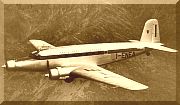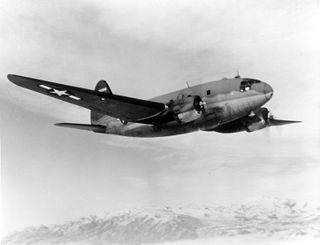
The Curtiss C-46 Commando is a low-wing, twin-engine aircraft derived from the Curtiss CW-20 pressurised high-altitude airliner design. Early press reports used the name "Condor III" but the Commando name was in use by early 1942 in company publicity. It was used primarily as a cargo aircraft during World War II, with fold-down seating for military transport and some use in delivering paratroops. Mainly deployed by the United States Army Air Forces, it also served the U.S. Navy/Marine Corps, which called it R5C. The C-46 filled similar roles as its Douglas-built counterpart, the C-47 Skytrain, with some 3,200 C-46s produced to approximately 10,200 C-47s.

The SNCASE S.E.2010 Armagnac was a large French airliner of the late 1940s built by SNCASE (Sud-Est). The aircraft's disappointing performance and range prevented it from achieving commercial success. Although the SNCASE Armagnac did not have a sterling career, its passenger compartment design gave it a much roomier feel and greater capacity and foreshadowed the future wide-body jet airliners.
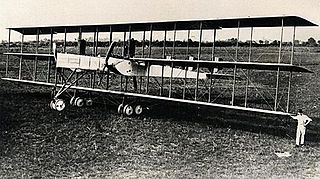
The Caproni Ca.4 was an Italian heavy bomber of the World War I era.

The Superga air disaster occurred on 4 May 1949, when a Fiat G.212 of Avio Linee Italiane, carrying the entire Torino football team, crashed into the retaining wall at the back of the Basilica of Superga, which stands on a hill on the outskirts of Turin. All thirty-one people on the flight died.

The Douglas C-74 Globemaster was a United States heavy-lift cargo aircraft built by the Douglas Aircraft Company in Long Beach, California. The aircraft was developed after the Japanese attack on Pearl Harbor. The long distances across the Atlantic and, especially, Pacific oceans to combat areas indicated a need for a transoceanic heavy-lift military transport aircraft. Douglas Aircraft Company responded in 1942 with a giant four-engined design. Development and production modifications issues with the aircraft caused the first flight to be delayed until 5 September 1945, and production was limited to 14 aircraft when the production contract was canceled following V-J Day.

The Airspeed Consul is a twin-engined light transport aircraft and affordable airliner designed and produced by the British aircraft manufacturer Airspeed Limited. Introduced during the immediate post-war period, it was a straightforward conversion of surplus Airspeed Oxford military trainers that had been extensively used during the Second World War.

The Fokker F.VII, also known as the Fokker Trimotor, was an airliner produced in the 1920s by the Dutch aircraft manufacturer Fokker, Fokker's American subsidiary Atlantic Aircraft Corporation, and several other companies under licence.
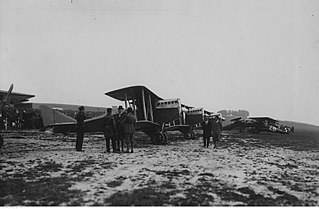
The Ansaldo A.300 was an Italian general-purpose biplane aircraft built by the Ansaldo company of Turin from 1920 to 1929. It also served as a light bomber, transport, fighter and reconnaissance aircraft, and finally as an advanced trainer, with examples in service as late as 1940. 50 examples were also license-built in Poland at ZM E. Plage & T. Laśkiewicz, but were not a success due to poor quality.

The Savoia-Marchetti S.73 was an Italian three-engine airliner that flew in the 1930s and early 1940s. The aircraft entered service in March 1935 with a production run of 48 aircraft. Four were exported to Belgium for SABENA, while seven others were produced by SABCA. The main customer was the Italian airline Ala Littoria.

The Junkers G 24 was a German three-engine, all-metal low-wing monoplane passenger aircraft manufactured by Junkers from 1925. Junkers F 24 was the designation for single-engine versions of the same aircraft.

The Albatros L 73 was a German twin-engined biplane airliner of the 1920s. Of conventional configuration, it featured a streamlined, boat-like fuselage and engine nacelles. All four manufactured aircraft of that type were operated by Deutsche Luft Hansa, one of which crashed near Babekuhl on 28 May 1928.

The Piaggio P.166 is an Italian twin-engine pusher-type utility aircraft developed by Piaggio Aero. The aircraft model name was Portofino, and is also known as Albatross in South African military service.

The Fokker F.IX was an airliner developed in the Netherlands in the late 1920s, intended to provide KLM with an aircraft suitable for regular services to the Dutch East Indies. When the onset of the Great Depression forced the postponement of those plans, the market for this aircraft disappeared as well, although it did see military service in Czechoslovakia as a bomber.

The Savoia-Marchetti SM.95 was an Italian four-engine, mid-range transport aircraft, which first flew in 1943. It was the successor of the Savoia-Marchetti SM.75.

The Fiat G.12 was an Italian transport aircraft of World War II.
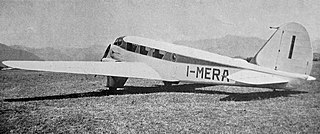
The Caproni Ca.308 Borea was a small airliner built in Italy in the mid-1930s.
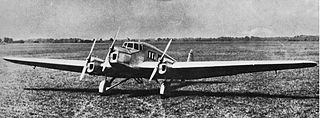
The Fiat G.2 was an Italian three-engine six-passenger monoplane transport aircraft designed by Giuseppe Gabrielli and built by Fiat.

The Fiat G.18 was an Italian airliner developed in the mid-1930s.

The Lioré et Olivier LéO 21 was a 1920s French biplane airliner and later military transport based on the earlier LéO 20 night bomber.
Avio Linee Italiane (ALI) was an Italian independent airline owned by the Fiat Group, which operated between 1926 and 1952. It was ultimately acquired by Linee Aeree Italiane (LAI). ALI was the country's only pre-World War II airline not to be nationalized by the Italian Government.
